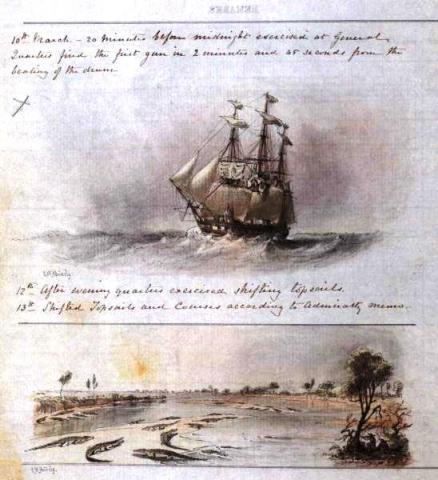Essential Information
| Location |
National Maritime Museum
|
|---|---|
18 Aug 2011
The ‘journal of cruise of H.M. Ship Maender’ kept by Captain Henry Keppel and beautifully illustrated by Oswald Brierly.
The journal documents a voyage throughout the southern hemisphere undertaken between 1847 and 1851.

Whilst employing language we would frown at today, Keppel provides an account of contact with people from New Ireland, Papua New Guinea, writing that the ship was approached by 'numerous canoes with the most extraordinarily painted savages we had ever seen … offering fruit, spears, tortoiseshell, coconuts and curiosities in exchange for empty bottles, bits of iron hoop etc.' As an historical record of the actions and mentalities of those from past generations passages like this are, of course, exceedingly revealing.
Lest we get carried away however, it is always clear that this is the journal of a naval man with naval preoccupations, albeit written with a flourish of linguistic style. Thus, Singapore is described by Keppel as a place of international trade, 'the emporium of all the commercial tribes of the Eastern Archipelago'. With typical imperialist gusto he writes of the 'magical result' of Sir Stamford Raffles endeavours.
Rather less complimentary comments are reserved for Sir John Davis, former governor of Hong Kong, for his treaty of 1847 supposedly ensuring foreign access to the city of Canton two years later. At the idea that the Chinese would not uphold the treaty, Keppel’s belligerent approach to diplomacy is revealed when he sarcastically notes that 'we shall submit to any indignity rather than have recourse to hostilities'. Of the treaty itself he simply writes: 'one folly leads to another'; a turn of phrase we might all do well to remember.
Whilst in Chinese waters Keppel had opportunity to investigate the prevalent system of piracy then operating in the area. Accompanied by Brierly’s fine image, he reports on the disappearance of 'several opium clippers'.
Captain, later Admiral, Sir Henry Keppel was a naval officer of great ability and courage. The sixth son of the fourth earl of Albemarle, Keppel entered the navy at the age of 12 and served in the West Indies and on the China station. In 1847 he was appointed to the Maender and began the voyage described in the journal.
An active man who excelled in combat, upon arriving in Tasmania, Keppel perhaps demonstrated why his entry in the Oxford Dictionary of National Biography described him as a man 'too excitable and hasty to be a successful admiral in peacetime'. With no genuine fighting to be done, the crew of the Maender staged a mock battle much to the delight of the residents of Hobart. Quite how successful a morale-boosting exercise it was for the crew of the Maender is another matter, as their attack was repulsed by the defending regiment.
Many of the events that Keppel describes were witnessed by the marine painter Sir Oswald Brierly who had joined the Maender in 1850. He was onboard the ship when it sailed from New Zealand on 10 June 1850, whereupon she cruised along the coasts of Chile, Peru and Mexico, finally arriving at Spithead, 29 July 1851. In fact, one might imagine that it is Brierly, directed by the pointing figure of Keppel, sat sketching Norfolk Island in one of the images.
Brierly, an artist of some renown, would sail with Keppel on two further ships during the Crimean War. Often coming under enemy fire he was employed by the Illustrated London News to sketch the engagements he witnessed. Throughout the Maender journal his skill at suggesting movement and action in his illustrations (precisely the skills so valued by the Illustrated London News) shines through, making the volume as exciting as it is informative.
Richard, Assistant Archivist